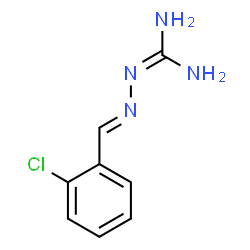| Cas No.: | 13098-73-2 |
| Chemical Name: | 2-[(e)-(2-chlorophenyl)methylideneamino]guanidine |
| Synonyms: | 2-[(E)-(2-chlorophenyl)methylideneamino]guanidine;(2E)-2-(2-Chlorobenzylidene)hydrazinecarboximidamide;hydrazinecarboximidamide, 2-[(2-chlorophenyl)methylene]-, (2E)-;Sephin 1 |
| SMILES: | ClC1C=CC=CC=1/C=N/N=C(/N)\N |
| Formula: | C8H9N4Cl |
| M.Wt: | 196.63686 |
| Purity: | >98% |
| Sotrage: | 2 years -20°C Powder, 2 weeks 4°C in DMSO, 6 months -80°C in DMSO |
| Description: | Sephin1 is a selective inhibitor of stress-induced PPP1R15A and targets disease associated with accumulation of misfolded protein. PPP1R15A is a regulator subunit of protein phosphatase 1 and regulates stress-induced eIF2α (α subunit of eukaryotic translation initiation factor 2). It brings PP1 (serine/threonine-protein phosphatase) to dephosphorylate eIF2α. Phosphorylation of eIF2α reduces protein synthesis and prevents the accumulation of misfolded protein in ER (endoplasmic reticulum). Thus inhibiting PPP1R15A prolongs the phosphorylation of eIF2α, and benefits the treatment for protein misfolding disease. In cells treated with 5μm Sephin1 for 6 hours, Sephin1 specifically disrupted the PPP1R15A-PP1c complex without affecting PPP115B-PP1c complex. As a consequence, Sephin1 prolonged eIF2a phosphorylation in HeLa cells after stress (*2.5 μg/ml tunicamycin treatment) and delayed translational recovery. Sephin1 recused cell from cytotoxic ER stress* in wild-type cell but not the PPP1R15A mutant cell. In mice administrated orally with 1-5mg/kg Sephin1 for given time, Sephin1 exhibited no adverse effects on rotarod performances, total body weight gain or memory. Treating MPZ (Deletion of serine 63 of myelin protein zero) mutant mice with 1mg/kg orally twice a day, prevented the molecular, morphological and motor defects. Oral treatment of 5 mg/kg of Sephin1 once a day, prevented motor deficits, motor neuron loss and the molecular defects in SOD1 (Mutant and misfolding-prone superoxide dismutase 1) mutant mice. |

 DC Chemicals' products qualify for U.S. tariff exemptions. We guarantee no price increases due to customs duties and maintain stable supply, continuing to deliver reliable research solutions to our American clients.
DC Chemicals' products qualify for U.S. tariff exemptions. We guarantee no price increases due to customs duties and maintain stable supply, continuing to deliver reliable research solutions to our American clients.





















